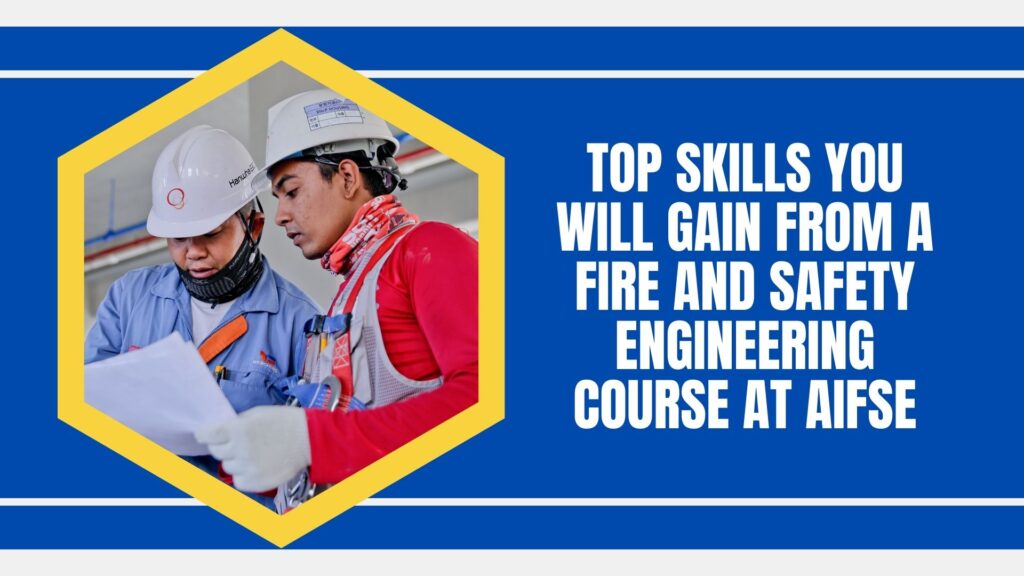
In today’s fast-paced industrial world, safety is not just a regulatory requirement—it is a moral, ethical, and operational necessity. With rapid industrialization, urbanization, and technological advancement, the demand for trained fire and safety engineers has increased significantly across the globe. Organizations need skilled professionals who can manage risks, design safer workplaces, and respond effectively in case of emergencies.
The Academy of Industrial Fire and Safety Engineering Course (AIFSE) has emerged as a reputed institution that equips students with the technical knowledge and practical expertise required to succeed in this vital field. The courses at AIFSE are carefully designed to provide both theoretical foundations and hands-on training, ensuring that students graduate with industry-ready skills.
If you are considering a career in fire and safety, here are the top skills you will gain from a Fire and Safety Engineering course at AIFSE.
1. In-Depth Understanding of Fire Science and Engineering Principles
One of the core skills students acquire is a scientific understanding of fire behavior—how fires start, spread, and can be controlled. At AIFSE, learners are taught the chemistry and physics behind combustion, heat transfer, and explosion dynamics. This knowledge forms the foundation for designing effective fire prevention systems and firefighting strategies.
- Ability to analyze fire risks in different environments (industrial, residential, commercial).
- Skills to select appropriate fire protection systems such as sprinklers, alarms, and extinguishers.
- Knowledge of fire-resistant materials and structural safety designs.
This scientific grounding ensures that graduates can make well-informed decisions to minimize fire risks.
2. Risk Assessment and Hazard Identification
A critical skill taught at AIFSE is risk management—the ability to identify potential hazards and evaluate their severity. Students learn systematic approaches like HAZOP (Hazard and Operability Study), FMEA (Failure Mode and Effects Analysis), and risk matrices.
Key competencies developed include:
- Recognizing fire and occupational hazards in workplaces.
- Conducting safety audits and inspections.
- Preparing comprehensive risk assessment reports.
- Implementing preventive measures to reduce accident likelihood.
By mastering risk assessment, graduates play a proactive role in preventing disasters before they occur.
3. Industrial Safety Management
Modern industries such as oil & gas, construction, manufacturing, and chemical plants face multiple risks. AIFSE’s curriculum places strong emphasis on industrial safety management—teaching students how to design, implement, and monitor safety programs within an organization.
- Planning and enforcing workplace safety regulations.
- Supervising the use of personal protective equipment (PPE).
- Training employees in safety protocols.
- Investigating accidents and implementing corrective actions.
With this skill, AIFSE graduates are capable of maintaining a safety-first culture in any industrial setting.
4. Disaster Preparedness and Emergency Response
Accidents, though preventable, can still occur. That is why emergency preparedness is a vital skill imparted during the course. Students are trained in both theoretical strategies and practical drills, preparing them to handle real-life crises.
Key aspects include:
- Developing and executing evacuation plans.
- First aid and medical response training.
- Coordinating with fire brigades, medical teams, and disaster management authorities.
- Crisis communication and leadership under pressure.
This ensures that graduates are ready not just to prevent accidents, but also to minimize damage and save lives during emergencies.
5. Knowledge of Safety Laws and Compliance Standards
Every organization must adhere to national and international safety regulations. At AIFSE, students learn about Indian safety laws, including the Factories Act, Explosives Act, and Environmental Protection Act, along with global standards like OSHA (Occupational Safety and Health Administration), NFPA (National Fire Protection Association), and ISO guidelines.
Skills gained:
- Ensuring workplaces comply with legal safety requirements.
- Preparing documentation for audits and certifications.
- Advising management on compliance with updated laws.
This knowledge makes graduates highly valuable, as companies often face penalties and reputational risks for non-compliance.
6. Leadership and Communication Skills
A safety officer is not just a technical expert but also a leader and communicator. At AIFSE, students are encouraged to build interpersonal skills, leadership qualities, and effective communication abilities.
Graduates learn how to:
- Train employees in safety protocols.
- Lead safety teams and supervise large groups.
- Communicate risks and safety measures clearly to both technical and non-technical staff.
- Handle conflict and motivate workers to follow safety practices.
This combination of technical and soft skills prepares students for managerial roles in the future.
7. Firefighting Techniques and Rescue Operations
Practical training is a major highlight of AIFSE’s programs. Students undergo rigorous sessions in firefighting and rescue techniques, learning how to operate extinguishers, hydrants, breathing apparatus, and rescue tools.
Hands-on skills gained include:
- Operating advanced firefighting equipment.
- Conducting rescue operations in confined spaces and high-rise structures.
- Handling hazardous materials (HAZMAT).
- Using thermal imaging and detection devices.
Such practical expertise makes AIFSE graduates job-ready from day one.
8. Environmental and Occupational Health Awareness
The course also emphasizes the connection between safety, health, and environment (SHE). Students learn how industrial practices impact not just workers but also the surrounding community and environment.
Skills include:
- Implementing sustainable safety practices.
- Monitoring air, water, and soil pollution in workplaces.
- Creating eco-friendly fire prevention systems.
- Promoting occupational health and wellness programs.
This holistic approach ensures that graduates contribute to sustainable industrial growth.
9. Technical Report Writing and Documentation
Documentation is an often-overlooked but crucial skill in fire and safety engineering. At AIFSE, students are trained to prepare accurate and detailed safety reports, inspection logs, and compliance documents.
- Writing incident and accident reports.
- Preparing safety manuals and training guides.
- Maintaining safety audit records.
- Using digital tools for report generation.
This skill enhances a graduate’s credibility and efficiency in professional roles.
10. Global Employability and Adaptability
Finally, one of the most valuable outcomes of an AIFSE course is the ability to work across industries and geographies. Since the curriculum aligns with international safety standards, graduates are not limited to opportunities in India—they can also pursue careers abroad.
- Adaptability to diverse work environments.
- Understanding cross-cultural workplace safety challenges.
- Meeting global demand for safety professionals in oil rigs, shipping, aviation, and construction sectors.
This global employability makes AIFSE graduates highly sought after worldwide.
Note: Check our other courses Fire and Safety QHS Courses
Conclusion
A Fire and Safety Engineering course at AIFSE is not just an academic qualification—it is a career-transforming experience. Students graduate with a unique blend of technical knowledge, practical expertise, leadership qualities, and global adaptability, making them valuable assets to industries worldwide.
From fire science and industrial safety management to emergency response, legal compliance, and global employability, the skills gained at AIFSE prepare graduates to create safer workplaces and communities. In a world where safety is paramount, the role of fire and safety engineers will only grow in importance—and AIFSE ensures its students are well-prepared to meet this challenge.



